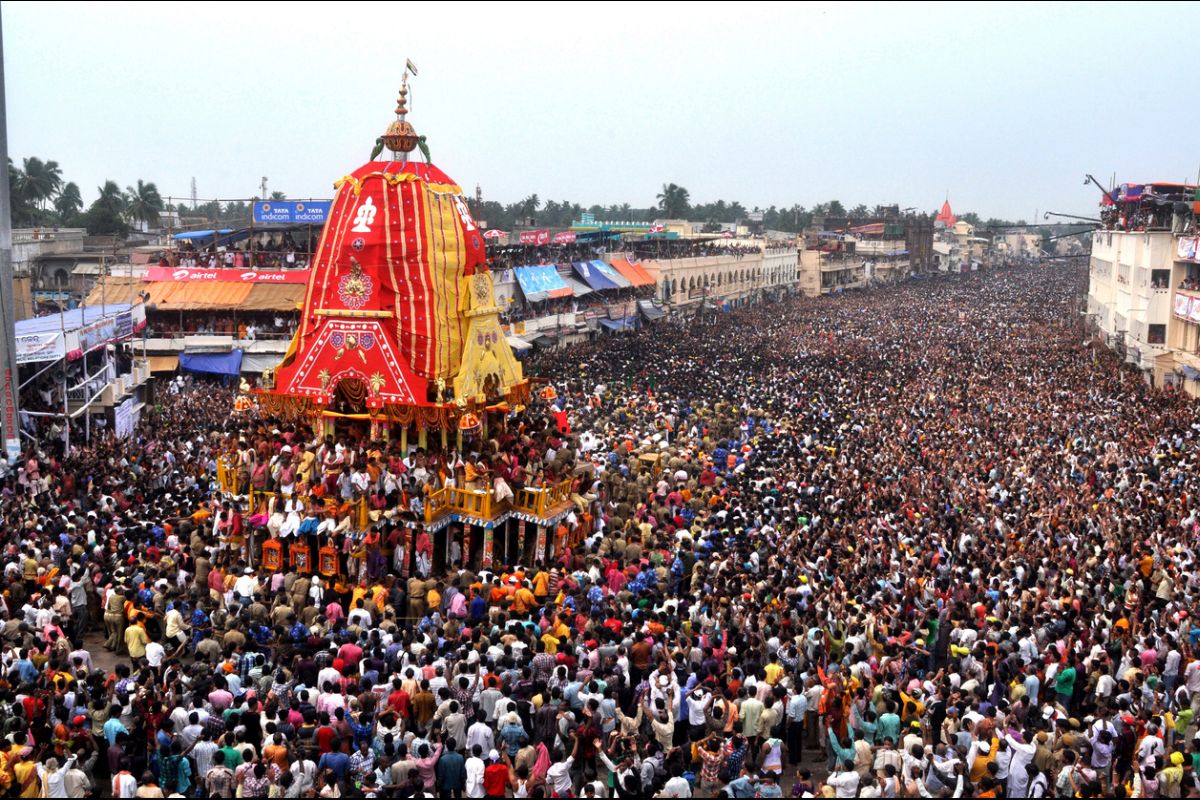Thousands of devotees flock to Puri every year to attend the Jagannath Rath Yatra. The centuries-old chariot procession is not only a religious ritual but also a showcase of how the Jagannath consciousness has long enriched the cultural heritage of Odisha. Sahapedia looks at how the dance performance of Gotipua forms such an integral part of the festivities.
The annual Jagannath Rath Yatra (Chariot Festival) in Puri, Odisha, is widely recognised as the oldest chariot procession of its kind and has led to similar processions being organised both across India as well as internationally. The Jagannath consciousness has long enriched the cultural heritage of Odisha, in terms of its art, architecture, literature, music and dance. And this influence is reflected in the artistic offerings that form a part of this ritualistic procession, as devotees offer their seva (services) through performing arts, such as telengi baja (rhythmic beating of gongs), banati khela (acrobatics), nagarakirtan (public singing and dancing). One of the oldest in the list is the traditional dance of Gotipua.
Advertisement
Goti-pua, meaning ‘single or only boy’, is the temple dancing tradition kept alive by young male dancers and has heavily influenced the modern-day classical dance, Odissi. After the decline of the mahari/devadasi (female temple dancers) system in the 16th century due to the diminishing in their social and financial status, the Gotipua dance—performed by pubescent boys impersonating female expressions—became the preferred divine performers in the temples of Lord Jagannath. The arrival of the mystic saint Chaitanya Mahaprabhu to Puri, around the same time, also helped increase its popularity in the region. Besides the daily temple rituals, Gotipuas also performed at special festivities related to the temple, such as Chandan Yatra and Rath Yatra.
Attracting thousands of devotees and visitors each year, the Rath Yatra is held during the Hindu month of Asadha (June–July, in the Gregorian calendar) in Purushottam Khstra (as Puri was once known). The three divine siblings go on their annual sojourn to the Gundicha temple—their ancestral home—accompanied with an ecstatic crowd on Badadanda, the stretch of road leading to the 12th-century shrine. The Gotipuas form a part of this frenzied procession.
Historian Sir W.W. Hunter describes the scene in A History of Orissa: ‘Music strikes up before and behind, drums beat, cymbals clash, the priests harangue from the cars…the dense mass struggles forward by convulsive jerks, tugging and sweating, shouting and jumping, singing and praying and swearing…’
During the Rath Yatra, Gotipuas perform on verses from Gita Govinda, a 12th-century Sanskrit work written by Jayadev depicting the relationship of Radha and Krishna. What appeals most to the audience are the graceful movements of the dancers, the acrobatics and the formation of human pyramids. Gotipuas successfully manage to hold the attention of the audience with their famous Bandha Nritya, a type of acrobatic dance (bandha, in Odiya, means limbs). To master the style, the boys start training as young as four-five in akharas to be able to enact the postures from the mythological scenes based on the life of Krishna as mentioned in the 17th-century manuscript Abhinaya Chandrika.
The Gotipua Tribute
During the Rath Yatra, the Gotipua performance starts when the deities are taken to their respective chariots in a pompous procession called Pahandi, meaning ‘coming step by step’ or ‘with gradual leaps’. It continues, along with the other rituals and performance tributes, till the end. Artistes, especially dancer-devotees get re-invigorated while offering their tribute, as they perform with a sense of spiritual surrender for their lord. After all, it is the only instance when Jagannath, brother Balabhadra and sister Subhadra leave their abode at the temple and come amidst the general populace for a direct interaction—keeping with the spirit of Jagannatha Swami Nayana Pathagami Bhaba Tume (May the Lord of the Universe be the Object of my Vision). ‘We artistes consider it an honour and privilege when we get an opportunity to offer our services and express our devotion to the Lord, directly irrespective of caste, creed and religion,’ says Odissi danseuse Dipti Routray.
Interestingly, the addition of Gotipua during the Rath Yatra began much after the origin of the festival itself. While the origin of the procession is not clear, historian Kailash Chandra Dash wrote in his essay ‘A Study of the Origin of Ratha Yatra in the Puruṣottama Kṣetra’, that the Rath Yatra was introduced as a separate festival ‘only in the Ganga period, i.e., after the 12th century A.D.’, that is, after the Jagannath temple was built. So, it is highly likely that initially the performative offering could have been given by the Maharis/Devadasis, which was then taken over by the Gotipuas around four centuries later.
The Salabega Connection
Gotipua has another indirect connection with the Rath Yatra as well, and that is through the 17th- century Muslim poet Salabega. Though the Gotipua performances are primarily based on Gita Govinda, they also find inspiration from the bhajans and jananas (devotional songs) of Salabega. According to legend has it that the Odiya poet, though Muslim by birth, was an ardent devotee of Lord Jagannath, much to the ire of local priests. One local version says that Salabega was once forcibly detained at home on the day of the Rath Yatra, but his desire and prayer to see Jagannath during the procession was so powerful that the chariot came to a halt in front of his house. It was only after Salabega had paid his respects that the chariot started moving again. Another version says that Salabega was ill and could not make it to the procession, so the chariot stopped until the devotee had his darshan.
In one of his poems, which forms a part of Gotipua performances even today, he wrote: Ahe nila saila, kahe Salabega hina jaati re mu jabana, Sriranga charan tale karuachhi janana (I am from another caste, seeking shelter under thy feet, oh blue mountain, referring to the god). Even today, the chariot makes a brief halt at his burial place during Rath Yatra, signifying the strong bondage of a great devotee towards the Lord.
This fascinating lore and the centuries-old tradition combined makes Gotipua an integral part of the famous Rath Yatra. So much so that despite the inclusion of many other performative arts into the festival, Gotipua continues to be a highlight.
(This article is part of Saha Sutra on www.sahapedia.org, an open online resource on the arts, cultures and heritage of India. The author is a Senior Fellow with the Union Ministry of Culture.)











